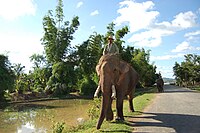Mnong people
 Mnong people during an elephant blessing ceremony in Buôn Đôn, Vietnam | |
| Total population | |
|---|---|
| Regions with significant populations | |
| Đắk Lắk, Đắk Nông, Lâm Đồng, Bình Phước - Mondulkiri - | |
| Languages | |
| Mnong, others | |
| Religion | |
| Christian, Theravada Buddhism, Animist |



The Mnong or Munong people (Vietnamese: người Mơ-nông) are an ethnic group mainly living in Central Highlands and Southeast regions of Vietnam, and Eastern region of Cambodia. They are made up of two main groups: Western Mnong and Eastern Mnong. Western Mnong includes smaller groups such as: Bhiet (Bhiat), Bu-Neur, Rehong, Kong-Khang, Ksèh, Nong, Prèh, Tí-Prì, Perong, Bu-Deung (Pou-Thong). Eastern Mnong includes: Gar, Briet, Kil (Chil), Krieng, Kesiong (Kyong), Rlam (Rolum) living mainly in mountainous areas.[2]: 145–146
Every group speaks a variant of the Mnong language, which along with Koho language, is in the South Bhanaric group of the Mon–Khmer family.[3]
A big community with around 47,000 people of Mnong live in the Cambodia's northeastern boundary province of Mondulkiri where they are known as Bunong (alternatively spelled Phnong, Punong, or Pnong).[citation needed]
Culture
Epics (Mnong language: Ot N'rong - Ot: telling by singing, N'rong: old story) take an important part in Mnong people's life. Many of these epics, such as Con đỉa nuốt bon Tiăng (Mnong language: Ghu sok bon Tiăng, English: The leech swallows Tiăng village),[4] or Mùa rẫy bon Tiăng (English: The farming season of Tiăng village) are quite long.[5]
Notable people
- Y Thu Knul (1828 – 1938), a Laos - Mnong person, a chieftain who established Buôn Đôn, a famous elephant hunting and taming village in Central Highlands. Y Thu Knul caught over 400 wild elephant in his life. In 1861, he caught a white elephant and gave it as a present to the Thai royal family, leading the king of Thailand to bestow upon him the name "Khunjunob" (literally "King of Elephant hunters").[6][7]
- N'Trang Lơng, a tribal chief who led villagers against French colonizers in a 24 years uprising from 1912 to 1935.[8] One of the most well-known action of N'Trang Lơng was the assassination of Henri Maitre - a French writer, explorer cum colonizer - who was famous for the adventure book Les Jungles Moï (English: Montagnard in Jungle, Vietnamese: Rừng Người Thượng), as well as brutal actions against the Mnong people.[9][2]: 12
- Điểu Kâu - an ethnologist, Điểu Klứt and Điểu Klung - two epic tellers, are three brothers in a family, who collected, recorded and spread M'nong epics. In August 2008, folk artist Điểu Kâu died of old age. This was a great loss for the M'nong people because they consider Điểu Kâu to be the keeper of their cultural identity.[10]
See also
References
- ^ Completed results of the 2019 Viet Nam population and housing census (Report). General Statistics Office of Vietnam. 17 October 2020. p. 43.
- ^ a b Henri, Maitre (2007). Les Jungles Moï (Rừng người Thượng) (Translated by Lưu Đình Tuân, Edited by Andrew Hardy and Nguyên Ngọc ed.). Hà Nội: Nhà xuất bản Tri thức. Retrieved 24 June 2024.
- ^ "Committee of Ethnic Minority Affairs - Introduction about M'nong people". cema.gov.vn. Retrieved 21 April 2022.
- ^ "Central Highland Epics". issch.vass.gov.vn. Retrieved 4 March 2022.
- ^ "Đăk Lăk Province's Library - Mùa rẫy Bon Tiăng". hdl.handle.net. Retrieved 5 March 2022.
- ^ "The legend about the white elephant". baodaklak.vn. Retrieved 20 April 2022.
- ^ "Elephant taming job of the M'Nong". vovworld.vn. Retrieved 8 July 2023.
- ^ "N'Trang Lơng Uprising 1912 - 1936". baodaknong.org.vn. 25 July 2012. Retrieved 22 February 2022.
- ^ "Tribal chief Lơng and the assassination of Henri Maître". cand.com.vn. Retrieved 20 April 2022.
- ^ "Keeping the Central Highland epics". tuoitre.vn. 30 June 2009. Retrieved 21 April 2022.
